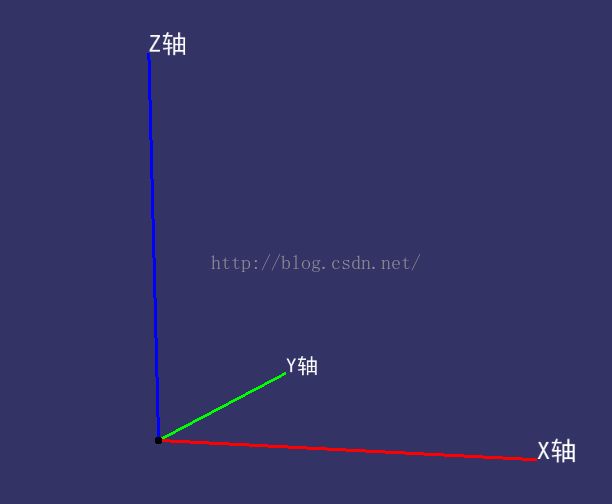OSG-简单的绘制一个坐标轴
学习了可绘制Drawable的基本知识,打算绘制一个简单的坐标轴。
效果图如下:
代码如下:
osg::Geode* makeCoordinate()
{
osg::ref_ptr pSphereShape = new osg::Sphere(osg::Vec3(0,0,0), 10.0f);
osg::ref_ptr pShapeDrawable = new osg::ShapeDrawable(pSphereShape.get());
pShapeDrawable->setColor(osg::Vec4(0.0, 0.0, 0.0, 1.0));
//创建保存几何信息的对象
osg::ref_ptr geom = new osg::Geometry();
//创建四个顶点
osg::ref_ptr v = new osg::Vec3Array();
v->push_back(osg::Vec3(0.0f, 0.0f, 0.0f));
v->push_back(osg::Vec3(1000.0f, 0.0f, 0.0f));
v->push_back(osg::Vec3(0.0f, 0.0f, 0.0f));
v->push_back(osg::Vec3(0.0f, 1000.0f, 0.0f));
v->push_back(osg::Vec3(0.0f, 0.0f, 0.0f));
v->push_back(osg::Vec3(0.0f, 0.0f, 1000.0f));
geom->setVertexArray(v.get());
//为每个顶点指定一种颜色
osg::ref_ptr c = new osg::Vec4Array();
c->push_back(osg::Vec4(1.0f, 0.0f, 0.0f, 1.0f)); //坐标原点为红色
c->push_back(osg::Vec4(1.0f, 0.0f, 0.0f, 1.0f)); //x red
c->push_back(osg::Vec4(0.0f, 1.0f, 0.0f, 1.0f)); //坐标原点为绿色
c->push_back(osg::Vec4(0.0f, 1.0f, 0.0f, 1.0f)); //y green
c->push_back(osg::Vec4(0.0f, 0.0f, 1.0f, 1.0f)); //坐标原点为蓝色
c->push_back(osg::Vec4(0.0f, 0.0f, 1.0f, 1.0f)); //z blue
//如果没指定颜色则会变为黑色
geom->setColorArray(c.get());
geom->setColorBinding(osg::Geometry::BIND_PER_VERTEX);
//三个轴
geom->addPrimitiveSet( new osg::DrawArrays(osg::PrimitiveSet::LINES, 0, 2)); //X
geom->addPrimitiveSet( new osg::DrawArrays(osg::PrimitiveSet::LINES, 2, 2)); //Y
geom->addPrimitiveSet( new osg::DrawArrays(osg::PrimitiveSet::LINES, 4, 2)); //Z
osg::ref_ptr pTextXAuxis = new osgText::Text;
pTextXAuxis->setText(L"X轴");
pTextXAuxis->setFont("Fonts/simhei.ttf");
pTextXAuxis->setAxisAlignment(osgText::Text::SCREEN);
pTextXAuxis->setCharacterSize(64);
pTextXAuxis->setPosition(osg::Vec3(1000.0f, 0.0f, 0.0f));
osg::ref_ptr pTextYAuxis = new osgText::Text;
pTextYAuxis->setText(L"Y轴");
pTextYAuxis->setFont("Fonts/simhei.ttf");
pTextYAuxis->setAxisAlignment(osgText::Text::SCREEN);
pTextYAuxis->setCharacterSize(64);
pTextYAuxis->setPosition(osg::Vec3(0.0f, 1000.0f, 0.0f));
osg::ref_ptr pTextZAuxis = new osgText::Text;
pTextZAuxis->setText(L"Z轴");
pTextZAuxis->setFont("Fonts/simhei.ttf");
pTextZAuxis->setAxisAlignment(osgText::Text::SCREEN);
pTextZAuxis->setCharacterSize(64);
pTextZAuxis->setPosition(osg::Vec3(0.0f, 0.0f, 1000.0f));
osg::ref_ptr geode = new osg::Geode();
geode->getOrCreateStateSet()->setMode(GL_LIGHTING, osg::StateAttribute::OFF);
geode->getOrCreateStateSet()->setAttribute(new osg::LineWidth(3.0), osg::StateAttribute::ON);
geode->addDrawable(pShapeDrawable.get());
geode->addDrawable(geom.get());
geode->addDrawable(pTextXAuxis.get());
geode->addDrawable(pTextYAuxis.get());
geode->addDrawable(pTextZAuxis.get());
return geode.release();
} 